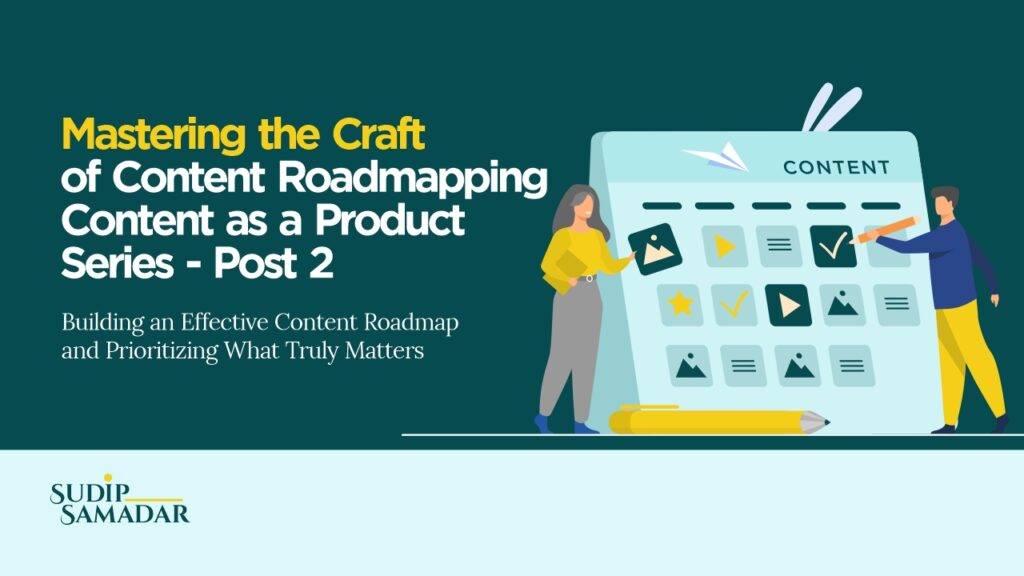
Why Every Startup Needs a Content Roadmap (Not Just a List)
If you’re leading content efforts at a startup—whether you’re the sole marketer, part of a small team, or even the founder—it’s crucial to create a content roadmap. You might already have something in place, but let’s be honest: if it’s just a list of ideas, it’s probably not helping you prioritize the right content—the kind that drives real results.
A content list is just that—a collection of ideas. It often lacks key considerations like potential impact, required effort, and alignment with your marketing goals. It probably doesn’t specify the target audience or define clear objectives. In contrast, a content roadmap incorporates all these elements and more, providing a structured plan for your content strategy.
When you take the time to prioritize your content based on these factors—much like a product leader builds a product roadmap—you’ll save significant time later in production and distribution. The effort you invest upfront will help you focus on high-impact content, streamline your growth efforts (even if you’re a team of one), and improve performance overall.
Yes, building a content roadmap may seem like a daunting task, especially in the early days of your startup. But it’s a game-changer that ensures your content is not just a creative endeavor but a strategic driver of growth. Your future self—and your growth team—will thank you.
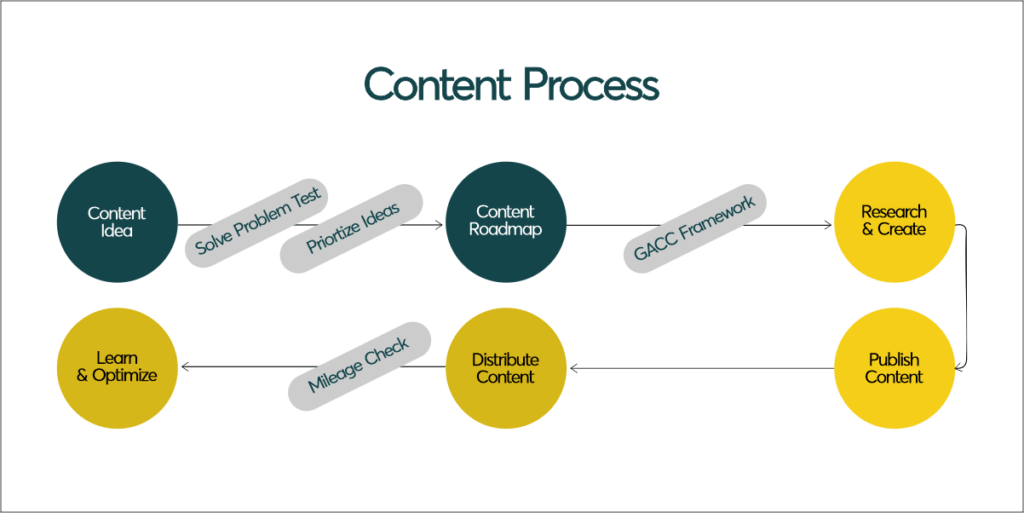
How to Generate Content Ideas: A Step-by-Step Guide
Creating impactful content starts with generating strong ideas, but to do it effectively, you need two tools: a content list and a content roadmap. Here’s how they work together:
- The Content List: A repository to capture all your content ideas as they come to you. Think of it as a parking lot for raw inspiration, free from prioritization or strategy at this stage.
- The Content Roadmap: A strategic plan that ensures you focus on high-impact content. It helps prioritize ideas based on their relevance, potential results, and alignment with your goals.
Guiding Principle for Content Ideas
Your content should always aim to solve your audience’s problems. This is the cornerstone of creating engaging and results-driven content. However, while this guiding principle is essential, it’s only the foundation. To create a balanced and effective roadmap, you need to go deeper.
How to Ensure Full Coverage in Your Content Roadmap
To cover all the bases, your content roadmap should account for:
- Audience Segments: Identify the different groups within your audience. Each segment will have unique pain points, goals, and preferences that your content should address.
- Problems You Solve: Map out all the issues your product or service resolves. Content that directly addresses these problems will resonate deeply with your audience.
- Stages of the Funnel: Ensure your content serves the entire customer journey:
- Awareness Stage: Content that introduces your brand and educates your audience.
- Consideration Stage: Pieces that showcase your value proposition and differentiate you from competitors.
- Decision Stage: Content designed to drive conversions, like case studies or testimonials.
Sourcing Content Ideas
To build a well-rounded content list, consider these methods for sourcing ideas:
- Customer Feedback:
- Review customer reviews, support tickets, and surveys to identify common questions or concerns.
- Use direct feedback to understand what your audience needs most.
- Competitor Analysis:
- Analyze competitors’ content to see what’s resonating with their audience.
- Identify gaps in their content strategy where you can offer something unique.
- Keyword Research:
- Use tools like Google Keyword Planner or SEMrush to find search terms related to your audience’s problems.
- Build content around trending or high-volume keywords that align with your offerings.
- Internal Team Input:
- Collaborate with sales and support teams—they often have valuable insights into customer pain points.
- Use their experiences to inform content that addresses real-world challenges.
- Social Media Trends:
- Monitor platforms where your audience is active to discover trending topics.
- Engage in conversations to find content opportunities.
- Audience Interactions:
- Use polls, quizzes, or open-ended questions on social media to directly ask your audience what they’d like to see.
- Funnel Gaps:
- Audit your existing content to identify stages of the funnel that need more attention.
- Create content to fill these gaps and improve the buyer journey.
Some groundwork is essential to create an effective content roadmap.
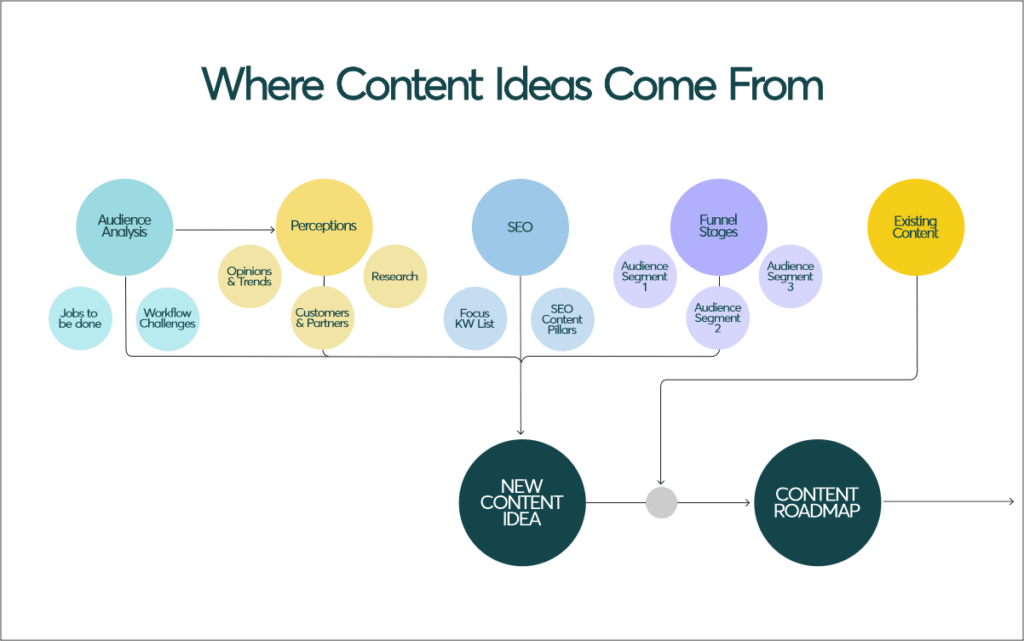
Audience Analysis: Understanding Your Content’s Core
What is Audience Analysis?
Audience analysis is the process of deeply understanding your target audience. This means analyzing each audience segment and ideal customer persona (ICP) to uncover:
- Jobs to be done: What tasks or objectives they are trying to accomplish.
- Challenges in their workflow: Problems or pain points they face daily.
- Other tools they use: Solutions or systems they rely on.
- Behavior and content preferences: How they engage with content and what resonates with them.
How to Conduct Audience Analysis:
- Expand Beyond ICPs: Identify audience segments that include both the companies you target and the individuals (ICPs) within them.
- Engage with Customers: Talk to your customers directly and consult with customer-facing teams like sales or support for insights.
- Use Templates: Leverage audience analysis templates (like the one provided in newsletters) for a structured approach.
Why It’s Crucial for a Content Roadmap:
Great content is built on a deep understanding of your audience—not just how they use your product but their broader workday challenges and needs. This allows you to focus your content on solving specific problems and creating value for them.
How to Generate Ideas from This:
Researching workflows and jobs to be done can inspire how-to guides, templates, tools, and other resourceful content pieces.
Perceptions: Shaping Your Brand Narrative
What are Perceptions?
Perceptions are concise statements that reflect what your company wants to be known for in the next year or more. They act as the brand tenets for your storytelling, helping to shape:
- Longer-form content
- Big ideas and opinions
- Customer stories
- Industry trends and data studies
How to Develop Perceptions:
- Create 3-4 unique perceptions that align with your brand and differentiate you from competitors.
- Base these perceptions on insights gathered during audience analysis.
- Ensure they reflect something only your company can authentically claim.
Example:
For Salesforce at its founding, a perception could be:
“No Software” – Software is moving to the cloud, and we are leading this movement.
Why It’s Essential for a Content Roadmap:
Perceptions provide a unifying framework for your content. Without them, your strategy may lack focus, making it harder to prioritize topics effectively.
How to Use Perceptions to Generate Ideas:
For each perception, brainstorm content ideas that reinforce that message. Plan these ideas quarterly to keep your storytelling consistent.
SEO Strategy: Building a Keyword Focus
What is a Focus Keyword List?
This is a targeted list of keywords you want to rank for. It includes:
- Your current ranking position
- Pages or posts that rank
- Traffic volume
- Keyword competitiveness
- Relevance to your audience
How to Create a Keyword List:
- Start Simple: Don’t aim for perfection—use a mix of relevancy, traffic potential, and competitiveness to prioritize.
- Leverage Content Pillars: Create themes or clusters of content that revolve around specific keywords.
- Use Tools: Platforms like Ahrefs can guide your keyword research effectively.
Why You Need It for a Content Roadmap:
A focused keyword list is essential for crafting an impactful content strategy. It helps prioritize which topics to cover and ensures progress tracking over time.
How to Use Keywords to Generate Ideas:
For each focus keyword, brainstorm content ideas that can rank well, such as blog posts, landing pages, or long-form guides. Additionally, tailor content to ensure it aligns with specific keywords and SEO goals.
By combining audience analysis, well-defined perceptions, and a solid SEO strategy, you create a comprehensive content roadmap that drives results, resonates with your audience, and strengthens your brand’s position in the market.
The Role of Funnel Stages in Content Creation

Why Funnel Stages Matter for Content
Funnel stages are not just for growth marketing—they are critical for creating and organizing effective content. By mapping your content to the stages of the funnel, you ensure it aligns with the buyer’s journey. Start by using the same funnel you’ve already defined for your marketing efforts and identify “anchor content” for each stage. Anchor content is the most impactful and useful piece for that specific stage.
How to Map Funnel Stages to Content
- Create a Content Inventory: List your existing content and categorize it by funnel stage (e.g., awareness, consideration, decision).
- Tailor to Your Sales Motion: If your company has a hybrid sales motion (e.g., free product, self-serve, and sales-assisted), you may need multiple funnel diagrams to map content effectively.
- Use Examples for Guidance: Simplified examples can provide a starting point, and detailed inventories can help refine your strategy further.
Why This Matters for Your Content Roadmap
If you create content without mapping it to funnel stages, you risk having significant gaps (missing critical touchpoints) or overlaps (wasting resources on redundant content). This mapping process ensures complete funnel coverage, aligns each piece with a clear purpose, and enables measurable goals for your content.
How to Generate Ideas Using This Framework
- Quarterly Review: Map your most effective content (anchor content) to each funnel stage for every audience segment and ideal customer persona (ICP).
- Identify Gaps: Pinpoint where you lack content and prioritize creating new materials to fill these gaps.
- Guide Growth Efforts: Use this mapping to steer your demand generation and growth marketing strategies, ensuring your content directly supports your objectives.
By integrating funnel stage mapping into your content planning, you’ll create a balanced, targeted, and impactful content roadmap that drives results across the entire customer journey.
The Importance of Leveraging Existing Content in Your Content Strategy
What Does This Mean?
When planning your content strategy, don’t focus solely on creating new content. Instead, consider how you can improve, expand, or repurpose existing content. This approach ensures you maximize the value of what you’ve already created.
How to Identify Content Worth Improving
- Analyze Performance Metrics:
- Traffic: Look at overall traffic and new user traffic to determine which pieces attract attention.
- Sources: Check where your traffic is coming from—organic search, social media, referrals, etc.
- Engagement: Assess how users are interacting with the content. Are they clicking on CTAs, filling forms, or sharing it?
- Consider Distribution Efforts:
- If a piece hasn’t performed well, ask yourself whether it was adequately distributed.
- Lack of distribution doesn’t mean the content is inherently bad; it may just need better promotion or tweaks.
- Select Opportunities to Improve:
- Identify content that already shows potential and could perform even better with updates or expanded coverage.
- Pinpoint pieces that align with your goals but may not have reached their full potential.
Why Include Existing Content in a Content Roadmap?
- Focus on Impact, Not Just Novelty: A successful content strategy isn’t about creating something new for the sake of it. The goal is to create impact, whether through fresh content or enhancing what you already have.
- Efficiency: Building on existing content often requires less effort than starting from scratch while still yielding significant results.
- Optimization: Updating and repurposing proven content ensures that high-potential pieces remain relevant and continue driving value.
How to Use This Insight for Content Ideation
- Catalog Existing Content: As you brainstorm new content ideas, also list existing pieces that could be updated, expanded, or repurposed.
- Prioritize Strategically: Treat new and existing content equally when building your roadmap. Consider the potential impact of each piece to determine priorities.
- Integrate Updates into Your Roadmap: Plan specific updates or expansions alongside the creation of new materials to ensure a balanced approach.
Example Workflow:
- Review analytics to find a blog post with high traffic but low engagement (e.g., few form fills or CTA clicks).
- Update the post by adding a stronger CTA, fresh examples, or updated statistics.
- Redistribute the improved post through social media, email campaigns, and paid ads to amplify its reach.
By integrating updates and repurposing into your content roadmap, you ensure that your strategy isn’t just about producing more but about maximizing the value of everything you create.
Exclusive Templates for Subscribers:
Subscribers can access all content and roadmapping templates here, including audience analysis and content inventory by funnel stage templates. These resources are essential inputs for crafting your final content roadmap, which is also available for subscribers. Not a subscriber yet? Join now and unlock these valuable tools!
Transforming Content Ideas into a Strategic Roadmap.
How to Transition Content Ideas into a Roadmap
If you’ve followed all the steps for pre-work—like audience analysis, defining perceptions, and mapping funnel stages—content ideas should start coming to you naturally. These ideas won’t need to be fully fleshed out initially. When inspiration strikes, jot down the concept quickly without worrying about adding all the details right away.
Moving from Ideas to a Roadmap
Once you have a list of ideas, the next step is to prioritize them. This is where the content roadmap comes in. A roadmap is more than just a list of topics; it’s a structured plan that helps you focus on high-impact content while aligning with your goals.
When you’re ready to add details—like target audience, funnel stage, or intended outcomes—transfer those ideas from your quick list to your content roadmap. Many teams already have some form of a roadmap, but often, it’s outdated or lacks the necessary information to make it actionable.
Staying on Top of Your Roadmap
To keep your content efforts effective and organized, dedicate time to maintaining and updating your roadmap. A practical approach is to do most of the heavy lifting quarterly. Use this time to evaluate your priorities, refine your focus, and map out the next few months of content work.
Additionally, revisit the roadmap monthly to make adjustments based on new insights, performance data, or changing priorities. This process works regardless of your team size or stage, ensuring your content strategy stays relevant and results-driven.
Detailing Each Content Idea for Your Roadmap
One common mistake in content roadmaps is failing to include the right details, leading to poor prioritization due to missing variables and context. To create a robust roadmap, it’s essential to track specific details systematically, whether in spreadsheet columns or custom fields in a project management tool like Asana (recommendations for Asana follow).
Key Fields to Include and Their Purpose:
- Audience Segment – To ensure your content targets the right group.
- Funnel Stage – To map content to where it fits in the customer journey.
- Primary Goal – To clarify what each piece of content aims to achieve.
- Effort Level – To gauge the time and resources required for creation.
- Impact Potential – To assess the expected value or outcome of the content.
- SEO Keywords – To align with your SEO strategy and boost search visibility.
By including these fields, your roadmap becomes a strategic tool for prioritizing and managing your content effectively.
Complete Roadmap Example:
Here’s a sneak peek at how a detailed content roadmap might look when structured in a spreadsheet.
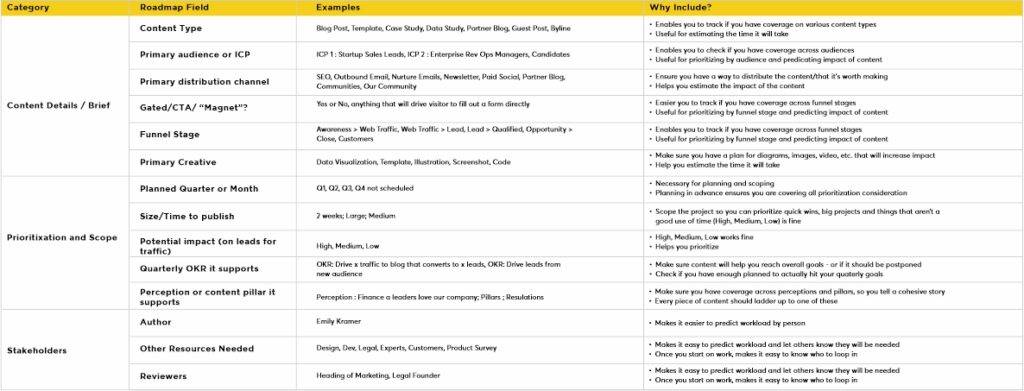
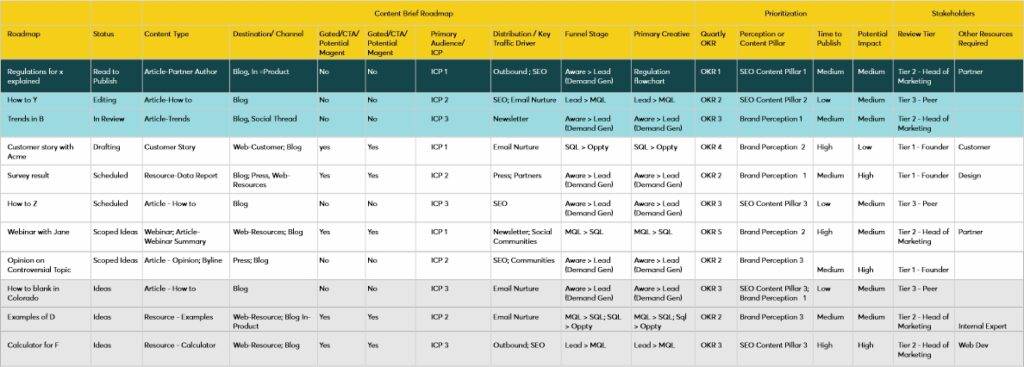
Big Bets: Identifying Blockbuster Content
In the world of content creation, success often hinges on blockbusters—game-changing pieces that, like angel investments or blockbuster movies, deliver outsized results. On your content roadmap, it’s crucial to flag any ideas with the potential to become blockbusters.
Ask yourself:
- Can this content drive a significant number of leads?
- Is it a bold, high-impact idea worth betting on?
- Could it serve as a lead magnet or cornerstone for your strategy?
Why Highlight Blockbusters?
These standout pieces are the “big swings” that can drive step-change growth for your brand. Including one or two blockbuster ideas per quarter ensures you’re always striving for transformative results, not just incremental gains. Without marking these high-potential items, you risk overlooking them in favor of smaller, routine tasks.
Making Blockbusters a Priority
Flagging these big bets on your roadmap allows you to set measurable goals around them, such as:
- “Create a high-impact lead magnet to drive X new leads.”
- “Launch Y major content initiative to achieve Z result.”
By identifying and prioritizing blockbuster content, you ensure your strategy includes bold moves that can significantly amplify your growth trajectory.
Effective Strategies for Content Prioritization
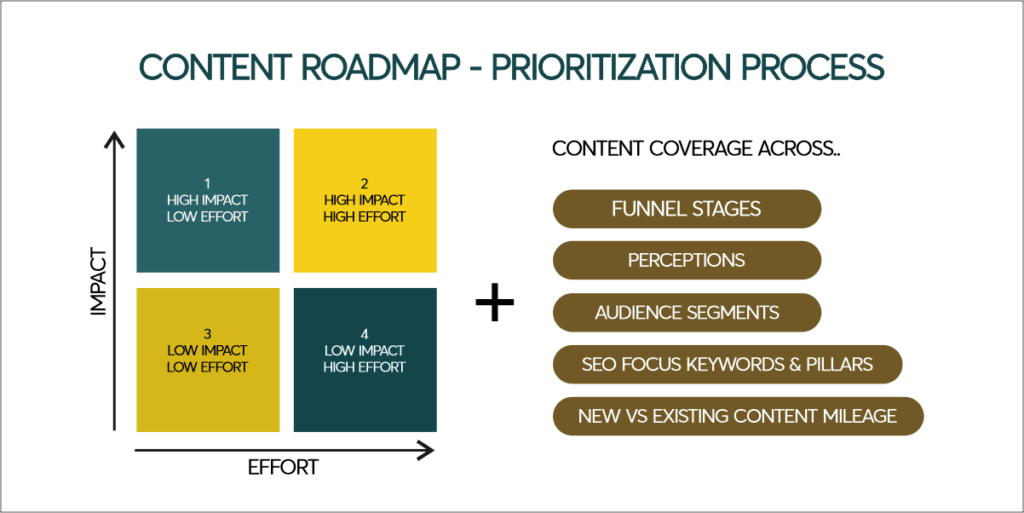
How to Effectively Prioritize Content for Maximum Impact
Content should be prioritized with the same strategic rigor as product managers prioritize features or engineering time. By evaluating through two key lenses—impact and effort and marketing strategy coverage—you can craft a balanced, high-performing content roadmap.
Step 1: Evaluate Impact and Effort
Content prioritization begins by assessing the balance between potential impact and required effort.
- Impact Estimates: Categorize content ideas as having high, medium, or low potential for driving leads or traffic.
- Effort Estimates: Similarly, assess the time and resources required to create each piece using high, medium, or low labels.
Focus on:
- High-Impact, Low-Effort Content: These should often take precedence because they offer the best return on investment.
- High-Impact, High-Effort Content: Prioritize these selectively for their potential to create significant results (e.g., blockbusters) or to achieve essential strategic coverage.
For high-effort content, consider its ability to align with overarching business goals or address critical gaps in your marketing strategy.
Step 2: Ensure Coverage Across Key Areas
While high-impact content is crucial, focusing solely on one area (e.g., a single funnel stage or audience segment) can dilute overall results. Balance is key.
- Content Grouping: Organize potential content by:
- Content type (e.g., blog posts, videos, case studies)
- Audience segment
- Funnel stage (awareness, consideration, decision)
- Selection: Within each category, prioritize the top 1–3 items depending on capacity.
For example:
- Select 2–3 pieces to address gaps in your funnel.
- Choose content types beyond blog posts to diversify your output.
- Ensure your chosen content ties back to your brand story and core perceptions.
Finalizing and Implementing the Roadmap
- Resource Check: Verify that your team’s capacity can handle the proposed workload, including contributors, reviewers, and owners.
- Quarterly Cut: Refine your list to include only the most achievable and impactful items for the quarter.
- Monthly Planning: Pull content from the quarterly roadmap into a detailed monthly plan to stay focused and adaptive.
Closing Note
By aligning impact, effort, and strategic goals, your content roadmap will not only achieve balance but also drive measurable results. Remember, a well-prioritized roadmap doesn’t just guide content creation—it ensures every piece contributes meaningfully to your marketing objectives.
